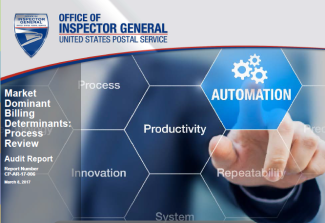Market Dominant Billing Determinants: Process Review
Background
Billing determinants are spreadsheets U.S. Postal Service employees manually produce to report volume and revenue for every price in each market dominant mail class. The five market dominant classes for which billing determinants are produced are: First-Class Mail, Periodicals, Standard Mail, Package Services, and Special Services.
The Postal Accountability and Enhancement Act of 2006 capped price increases for each class of market dominant mail to the change in the Consumer Price Index. The Postal Service uses billing determinants to estimate future revenue, develop prices for each class of mail, and ensure price increases do not exceed the Consumer Price Index. The billing determinants are also included in the Annual Compliance Report produced for the Postal Regulatory Commission, and are used to develop cost estimates and mailer discounts.
The total revenue for market dominant products for fiscal year 2016 was over $52 billion. Prior audits identified data entry errors due to the manual preparation and complexity of the billing determinant spreadsheets.
Our objectives were to assess the efficiency of the billing determinant processes and evaluate the actions implemented in response to recent U.S. Postal Service Office of Inspector General audits to improve the internal controls.
What the OIG Found
Opportunities exist to enhance the documentation of the billing determinant process, procedures, and internal controls. The Postal Service did not finalize standard operating procedures in response to prior audit recommendations. While the Postal Service has taken some initial steps to create standard operating procedures, the current documentation is not sufficient to accurately capture necessary details of the processes. Postal Service management considers current standard operating procedure drafts adequate; however, they did not perform validation to ensure the documented procedures were complete. Without comprehensive procedures, the Postal Service risks further billing determinant calculation errors.
Additionally, opportunities exist to improve internal control security over billing determinant data. Billing determinant spreadsheets containing both market dominant and competitive data are not encrypted, password protected, or otherwise secured during transmission. The Postal Service believes its network security is adequate to protect sensitive billing determinant data; however, its policy requires sensitive information be encrypted to prevent misuse. Without adequate safeguards, this sensitive, proprietary information is at risk for unauthorized access.
Finally, opportunities exist to enhance the accuracy and completeness of billing determinant calculations. The Postal Service requires preparers of billing determinant spreadsheets to manually update, calculate, and visually verify formulas and source data. The current manual process does not allow management to effectively prevent, detect, and correct miscalculations. The Postal Service allocates 10 days each quarter for five economists to manually develop the billing determinant spreadsheets. This manual process caused the Postal Service to submit inaccurate billing determinant calculations to the Postal Regulatory Commission.
What the OIG Recommended
We recommended management finalize the current documented billing determinants procedures so that processes are sufficiently detailed and repeatable to internally validate the billing determinant data.
We also recommended management properly encrypt, password protect, or otherwise secure billing determinant spreadsheets and the supporting data.
Finally, we recommended management implement automation options to improve data accuracy and revenue calculation techniques.

